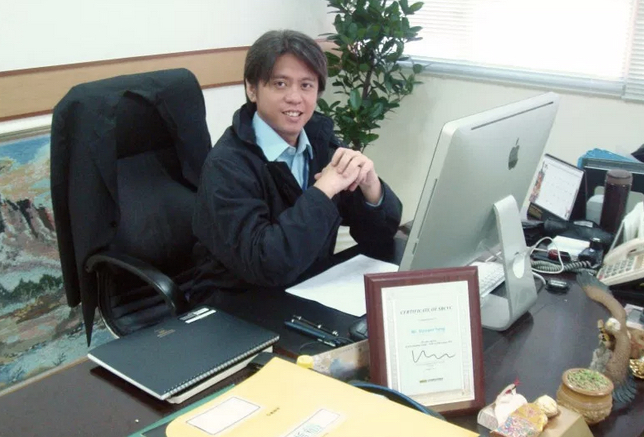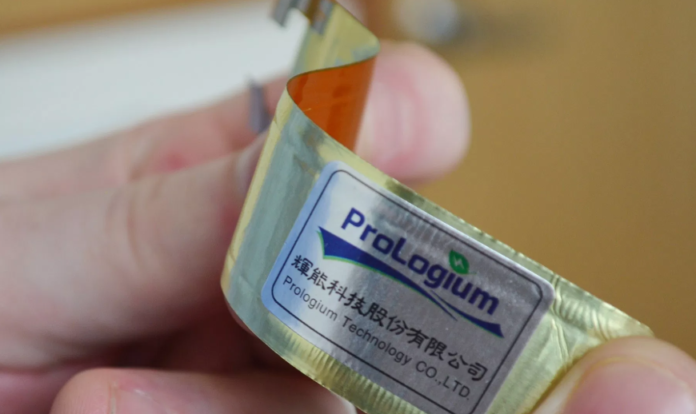
Solid-state batteries will power half of the electric vehicles in 2030, up from practically zero right now, predicts a Taiwanese company. As EV sales are expected to increase in the decades ahead driven by tighter regulation, solid-state battery makers may just become the next rising stars in the renewable energy industry.
“I think overall solid-state battery products will account for a small proportion in the market by 2024 and 2025, because not many market players will have the capability to realize the mass production. However, I think overall solid-state battery products will take up more than 50% of the market share by 2030,” said Taiwanese solid-state battery maker ProLogium Technology’s founder and CEO Vincent Yang Sinan in a phone interview with China Money Network last month.
Most automakers in the world including Japanese auto giant Toyota have drawn a timeline to achieve mass production of solid-state electric vehicle batteries in 2025 and after. ProLogium said it aims to achieve mass produce solid-state batteries in early 2021.
“ProLogium is in the process of constructing a G2 [production] line, which will have one gigawatt hour (GWh) production capacity per year. We plan to start to test the new G2 line around the middle of 2020, and then realize the mass production in early 2021,” said Vincent Yang Sinan. “We think ProLogium will take up about 10% to 15% market share by 2025, and then the proportion will be adjusted to 30% to 35% by 2030.”
ProLogium, which is not yet profitable, plans to focus on delivering solid-state batteries to electric vehicle makers in the next three to five years. Currently, all its solid-state batteries are adopted by wearable devices, internet of things (IoT), and other consumer products.
Deloitte’s research shows the pace of global EV adoption rising from two million units in 2018, to four million in 2020, 12 million in 2025, before rising to 21 million in 2030. Most electric vehicles nowadays are powered by lithium-ion batteries which have a higher energy density, longer life span, and higher power density. But they face some complicating factors, such as safety, durability, and thermal breakdown that highly restrict the usage.
These problems can be addressed potentially by solid-state batteries, which are considered by many EV producers, automakers and energy storage engineers as the future of electric vehicles and pretty much anything else that needs a battery. Theoretically, a solid-state battery should be able to accept a charge at a much higher rate than current battery systems, store much more energy in a smaller space, and perform in a much safer manner since there is no finicky and flammable liquid gel or polymer electrolyte involved.
However, the problem is that no solid-state battery makers are able to mass produce their products and at this point, creating a solid-state battery the size of the common AA would likely cost thousands of U.S. dollars.
The Taiwan-based company, once low-profile and mysterious about its fundraising progress, unveiled that SoftBank Venture Capital was the lead investor in its series A to series C rounds. Claimed to have entered the unicorn club, the company also felt “some reservations” from the investor’s side in pouring money into start-ups during a capital winter since mid-2018.
ProLogium is raising US$150 million in a series D round that is expected to reach the first closing in the second quarter of 2019. The final closing is expected to be in late 2019 or early 2020.

Established by Yang in October 2006, ProLogium has developed four major product pipelines for the production and sales of flexible-type LCB “FLCB,” high capacity-type LCB “PLCB,” and high voltage-type LCB “BLCB.” The 13-year-old company said it has obtained 129 patents worldwide in fields like battery design, battery manufacturing technique and equipment, and product applications as of March 2019, with 83 more patents in the application process.
Below is an edited version of the interview.
Q: ProLogium is actively developing solid-state batteries used for new energy vehicles, but we noticed the mass production of such products has not yet been realized as we can see some major automakers set the mass production agenda to maybe 2025 or even later.
What do you think is the current stage of Chinese solid-state electric-vehicle battery (EVB) industry?
A: ProLogium started to focus on the development of solid-state batteries since around 2006 and 2007, compared to our competitors who generally started around 2014, 2015, or even later. The average performance of our solid-state batteries can be even better than the liquid-state batteries, especially in terms of safety, fast-charging capability, high-temperature sustainability. However, based on what we learned from our shareholders, potential investors, and customers who involved in the electric vehicle (EV) production, I think Chinese solid-state battery makers cannot mass produce solid-state batteries until at least 2025.
Meanwhile, we have connections with a Chinese central government-level enterprise that provides automotive industrial services, policy research, engineering design and general contracting, and consultation. They want to help draft national regulations for the solid-state battery industry. We found the criteria they are considering about can help us evaluate the current industry progress. I think most solid-state battery makers in China have already gone into the engineering stage, in which they need to find and decide the better, or the most-optimized way, to mass produce solid-state batteries. Most solid-state battery makers already said they still need five to eight years before the mass production.
Q: When will ProLogium realize the mass production of solid-state batteries?
A: We already have a G1 line with a production capacity of 40 megawatt hours (Mwh) per year, and also on the process of constructing a G2 line which will have one gigawatt hour (GWh) production capacity per year. We plan to start to test the new G2 line around the middle of 2020, and then realize the mass production in early 2021.
We currently have the G1 production line, which can produce sufficient solid-state batteries to meet the demand of our corporate clients in wearable electronics and IoT (internet of things) industries. The upcoming G2 production line will be used to support the production and construction of EVs, robots, high-speed rails, and energy-storage systems.
Currently, all of our solid-state batteries are used to produce wearable devices, IoT and other consumer products. We will focus on realizing the mass production of solid-state batteries used for EVs in the following three to five years. However, the current production capacity of the G1 line is not large enough to make our products cost-effective for entering and competing in the market.
Q: Have ProLogium started to gain profits?
A: No, we haven’t. However, if we can retain about two million to three million U.S. dollars in monthly revenues, we may reach the break-even point in 2020 when an era of the application of solid-state batteries comes — especially the coming of application in high-speed rails which has a higher margin to help us earn more profits.
Q: Who are your major clients in the wearable devices and IoT industries? Who are your potential clients in the future?
A: Currently, we have realized the application of solid-state batteries in products like smart helmets, smart insoles, blue-tooth cards, fingerprint cards, vehicle GPS (global positioning system) devices, wireless barbecue temperature sensors, and semiconductor testing equipment used in the semiconductor industry.
In the semiconductor field, ProLogium has already sealed cooperations with companies including an America-based capital equipment firm and a Japanese electronics and semiconductor developer, which are both among the world’s top 10 semiconductor companies. We have also entered into agreements with one of America’s “Big Four” technology firms to produce wearable devices. (Editor’s Note: Specific company names are concealed due to non-disclosure agreements between ProLogium and its corporate clients.)
For our potential clients in the future, I think we will have opportunities to work with EV and motorcycle producers after the completion of our G2 production line in 2021. We have connections with around 13 automobile manufacturing companies in Germany, Japan, the United States, and mainland China. Some EV makers also knocked on the door to discuss and suggest us to consider transforming from the pure solid-state to the hybrid-state.
However, European automakers need to take a longer time — about seven years — starting from 2018 to around 2025 for next-generation solid-state batteries to be used in their EVs. I think most European automakers will still use liquid-state batteries before 2024.
In Japan, we have contact with automakers, as well as new-energy motorcycle makers to deliver solid-state battery-powered motorcycle in around 2020 to 2021, and realize the mass production of such model around 2022 to 2023. Certainly, solid-state batteries will be applied in motorcycles in a faster manner.
In mainland China, we have already entered into agreements with a state-owned automotive manufacturing company, and new energy start-up DearCC to provide them with solid-state batteries.
Q: You mentioned so many automakers, will the production capacity of ProLogium be able to meet their demand for solid-state batteries?
A: Right now, we have a new business model to license our technology. Many companies who combined have a great demand for solid-state batteries can apply for a license. This can quickly increase production capacity and reduce our costs. We have granted licenses to around 10 to 20 companies, including EV makers and battery producers who became members of our alliance.
Under the license model, alliance members can choose to either pay US$50 million as an upfront fee, or spend a certain amount of loyalty for each solid-state battery they produce. We also charge service fee every time when they get maintenance or upgrade services from us. Meanwhile, we will also sell key materials and core equipment used in the production of solid-state batteries. I understand that our core equipment could be duplicated if we adopt such business model in mainland China, but I don’t think it matters that much because companies outside of the mainland China still need to pay us due to the intellectual property protection.
I want to clarify that companies in some niche markets may still be able to use solid-state batteries directly produced by ProLogium in the future. Because one battery system cannot satisfy the varied demands of applications in different products — maybe it’s applicable to the EV industry, but not the wearable device, high-speed railway, or semiconductor applications. This is our combined strategy for the future.
Q: Do you think the license model will become a major source of revenues for solid-state batteries in the future?
A: I think, in the very beginning — probably from 2021 to 2023, we can directly produce solid-state batteries for the construction of high-speed rails or other high-yield products. After around 2023 and 2024, I think there will be more players joining us in the license model. If we assume that most solid-state battery makers can realize the mass production in 2023, I believe the number of market players adopting such license model will rapidly increase in 2024 and 2025, and it will become a main source of revenue for solid-state battery makers in the market.
Q: Solid-state batteries account for a very limited share in the current Chinese battery market. Let’s say if we want to see a market where solid-state batteries take up about 10% of the market share, how long will it take in your prediction?
A: We actually have a development plan measured by the market share. We think ProLogium will take up about 10% to 15% market share by 2025, and then the number will be adjusted to 30% to 35% by 2030. If this is the case, I think overall solid-state battery products will account for a small proportion in the market by 2024 and 2025 because not many market players will have the capability to realize the mass production. However, I think overall solid-state battery products will take up more than 50% of the market share by 2030.
Q: Some companies found it hard to raise money during the capital winter in 2018. Is the fundraising of ProLogium also being influenced?
A: A lot of investors are interested in the technologies, products, and business model of ProLogium, but certainly, venture capital investors have some reservations in pouring money into start-ups after mid-2018. SoftBank Venture Capital was the lead investor in our series A to series C rounds. ProLogium is raising US$150 million in a series D round that is expected to reach the first closing in the second quarter of 2019. The final closing is expected to be in late 2019 or early 2020.


